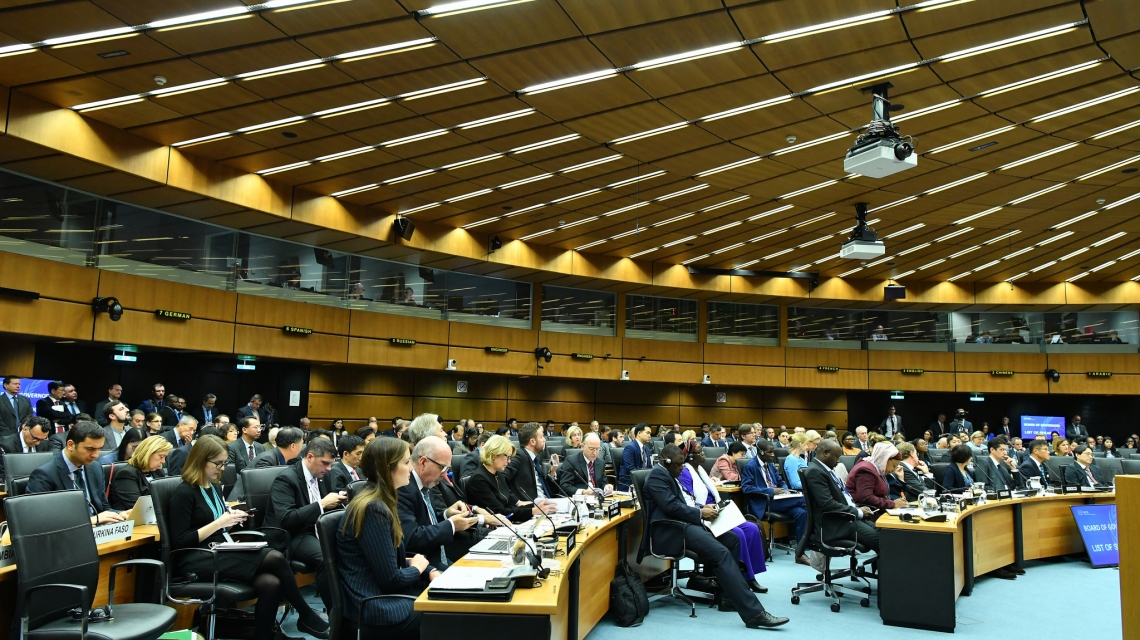IAEA Director General Yukiya Amano highlighted the good progress made in the delivery of technical cooperation (TC) projects, preparations for the 2020-2021 TC programme and the advances made to modernize the IAEA’s nuclear applications laboratories, in his opening statement to the Board of Governors today.
He encouraged the “development of more focused TC projects in which Member States, the IAEA and other partners can work together to help countries achieve their national development priorities.” He reminded delegates of the importance of all Member States contributing on time and in full to the TC Fund.
Nuclear applications
Mr Amano briefed Board members on the status of the renovation of the IAEA’s nuclear application laboratories in Seibersdorf, near Vienna. The upgrades will improve the IAEA’s capacity to support Member States in the use of nuclear techniques in food and agriculture, human health and the environment, as well as the use of new nuclear scientific instruments. A milestone in the modernization, the inauguration of the new Flexible Modular Laboratory, will take place during the Ministerial Conference on Nuclear Science and Technology next week.
“This phase of construction is fully funded, thanks to generous contributions of 32.4 million euros from 34 Member States and individuals. I am grateful to all of them,” he added.
He noted that an additional 3.75 million euros was urgently needed to equip the new facilities and to bring them into full operation. He encouraged all Member States in a position to contribute to do so.
Nuclear energy
Mr Amano told the Board that the Agency would be represented at next month’s UN Climate Change Conference in Katowice, Poland – known as COP24. The Agency will highlight the ways in which Member States can benefit from its services in climate change monitoring, mitigation and adaptation. “Our analytical tools for sustainable energy planning are now being used by around 150 countries and 21 international organizations,” the Director General added.
He also informed delegates about a pioneering expert meeting hosted by the Agency in October which considered hybrid energy systems, combining both nuclear and renewables, which can significantly reduce greenhouse gas emissions compared to conventional fossil fuels.
The IAEA has signed contracts for the purchase of low enriched uranium for the IAEA LEU Bank, which is nearing completion in Kazakhstan, Mr Amano said.
The IAEA LEU Bank will host a reserve of LEU and act as a supplier of last resort for Member States in case the supply of LEU to a nuclear power plant is disrupted due to exceptional circumstances and the Member State is unable to secure LEU from the commercial market or by any other means. “Our aim is to have the LEU delivered to the IAEA Storage Facility before the end of 2019,” he said.
Nuclear safety and security
Mr Amano welcomed Member States’ increased interest in the Agency’s nuclear safety and security peer review and advisory services. “In September, we conducted the 100th Integrated Regulatory Review Service (IRRS) mission in Hungary,” he said.
He drew attention to the International Conference on the Security of Radioactive Material, taking place in the first week of December, and the IAEA International Conference on Nuclear Security, scheduled for February 2020.
Nuclear verification
Mr Amano said many new ideas and practical proposals had resulted from the 13th Symposium on International Safeguards which took place earlier this month. “The focus was on building future safeguards capabilities by identifying innovative technologies and strengthening partnerships within the safeguards community and beyond,” he added.
Verification and monitoring in Iran
Turning to the IAEA’s verification and monitoring activities in Iran, Mr Amano said: “Iran is implementing its nuclear-related commitments under the Joint Comprehensive Plan of Action (JCPOA). It is essential that Iran continues to fully implement those commitments.”
“The Agency continues to verify the non-diversion of nuclear material declared by Iran under its Safeguards Agreement,” he added. “Evaluations regarding the absence of undeclared nuclear material and activities in Iran continue.”
North Korea
Regarding the nuclear programme of North Korea, officially known as the DPRK, Mr Amano noted that the Pyongyang Declaration issued at the inter-Korean Summit meeting on 19 September made reference to the country’s intention to “continue to take additional measures, such as the permanent dismantlement of the nuclear facilities in Yongbyon.”
At Yongbyon, further activities were observed near the Kuryong River but, without access, the IAEA cannot confirm their nature or purpose, he said. Agency inspectors were required to leave North Korea in 2009. “The Agency continues to enhance its readiness to play an essential role in verifying the DPRK’s nuclear programme if a political agreement is reached among countries concerned,” the Director General said.
Mr Amano called upon the DPRK “to comply fully with its obligations under relevant resolutions of the UN Security Council and of the IAEA Board, to cooperate promptly with the Agency and to resolve all outstanding issues.”






